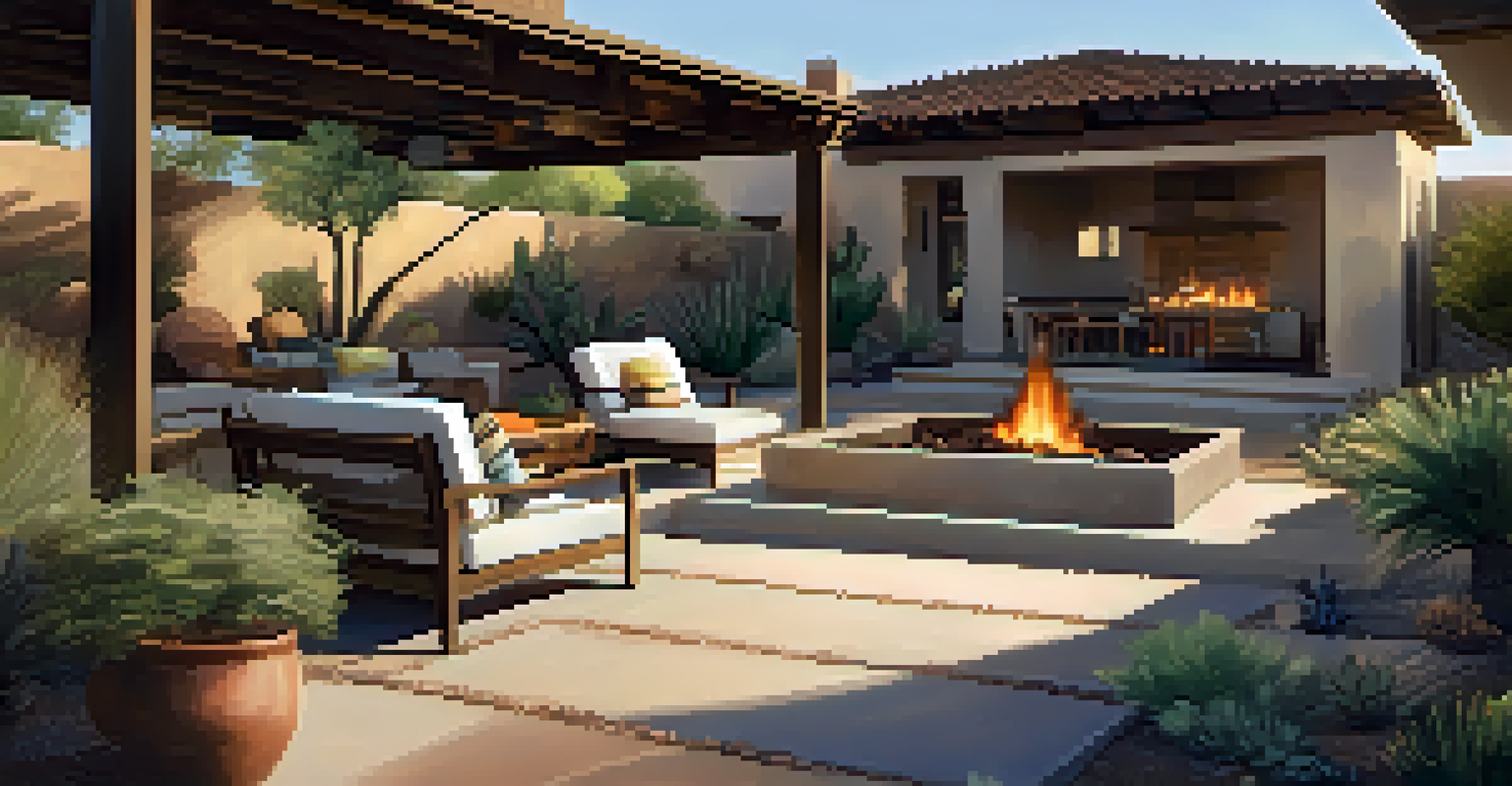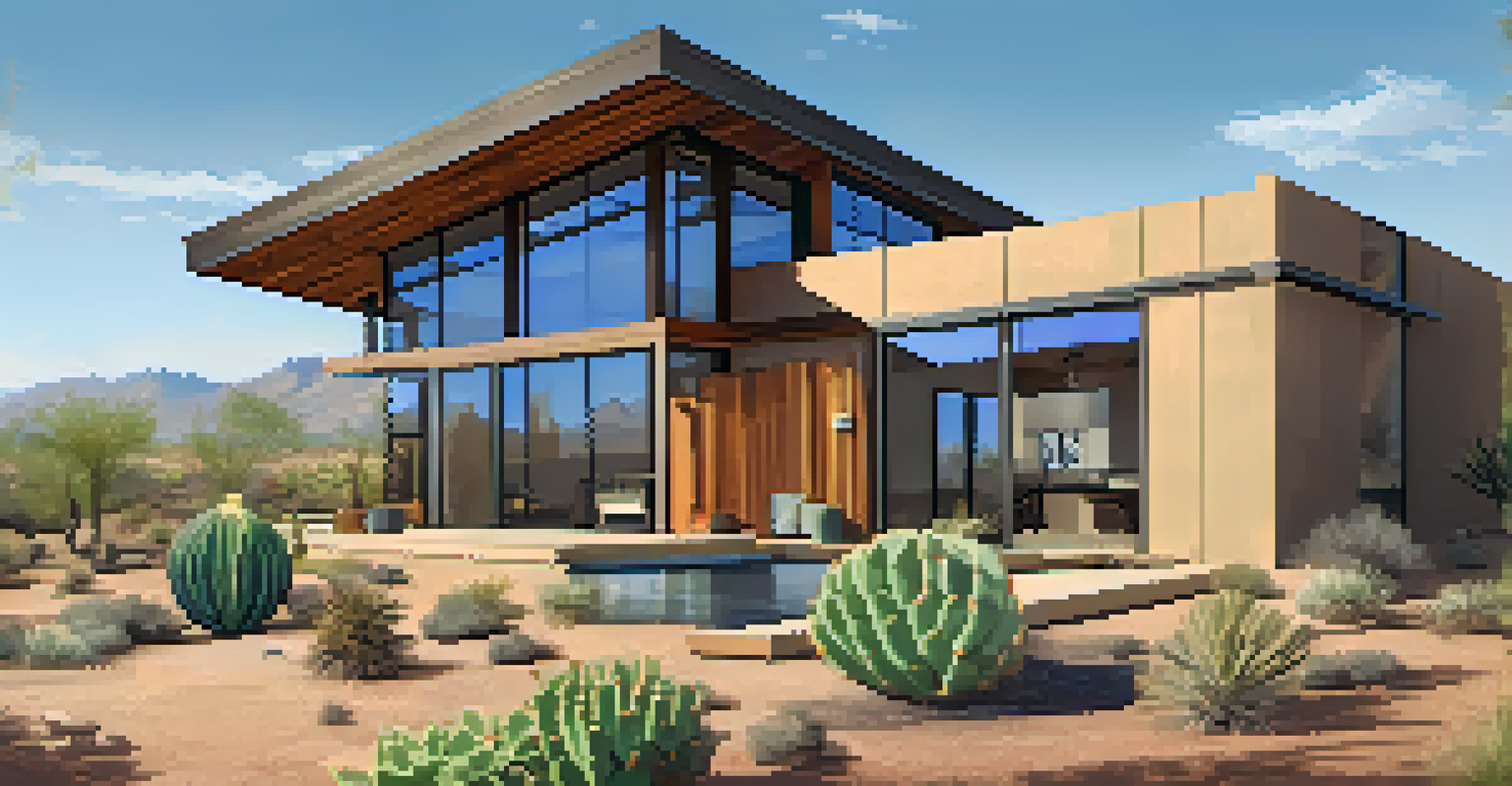The Impact of Desert Climate on Phoenix Architecture Styles

Understanding Phoenix's Unique Desert Climate
Phoenix is located in the Sonoran Desert, one of the hottest deserts in North America. This climate is characterized by scorching summers, mild winters, and minimal rainfall. The extreme temperature variations throughout the year create a unique challenge for architects and builders, who must consider how to keep interiors cool while maintaining comfort during the cooler months.
Architecture should speak of its time and place, but yearn for timelessness.
The intense sunlight and heat influence not only the materials used in construction but also the overall design of homes and commercial buildings. For instance, wide overhangs and shaded patios are common features that help protect from direct sunlight. These adaptations reflect a deep understanding of the local environment, ensuring that buildings remain functional year-round.
Understanding the nuances of Phoenix’s climate is essential for designing architecture that stands the test of time. Architects often draw inspiration from traditional desert dwellings that prioritize energy efficiency and natural cooling methods, which are vital in an area where air conditioning usage is high.
Incorporating Natural Materials in Design
The desert climate of Phoenix encourages the use of natural materials, such as adobe and rammed earth, which are not only aesthetically pleasing but also practical. These materials have excellent thermal mass, meaning they can absorb heat during the day and release it at night, helping to regulate indoor temperatures. This natural approach promotes sustainability and reduces reliance on artificial heating and cooling systems.

Moreover, the choice of colors and textures in architectural design often reflects the surrounding desert landscape. Earthy tones and rough textures blend seamlessly with the environment, creating a visually harmonious atmosphere. This connection to nature is cherished in Phoenix, as it emphasizes a lifestyle that respects and integrates with the desert ecosystem.
Phoenix's Climate Shapes Architecture
The unique desert climate of Phoenix necessitates innovative architectural designs that prioritize natural cooling and energy efficiency.
Using local materials also supports the local economy and reduces the carbon footprint associated with transporting materials from distant locations. This practice not only aligns with sustainable building efforts but also celebrates the region's heritage, making the architecture truly representative of Phoenix’s identity.
Emphasizing Outdoor Living Spaces
Given the warm climate, outdoor living spaces are a vital component of Phoenix architecture. Many homes feature expansive patios, courtyards, and outdoor kitchens, encouraging residents to enjoy the beautiful desert surroundings. These spaces are often designed to provide shade and comfort, allowing people to gather and socialize throughout the year.
The best way to predict the future is to design it.
Incorporating elements like fire pits, water features, and lush landscaping transforms outdoor spaces into inviting retreats. This design philosophy reflects the lifestyle of Phoenix residents, who value their connection to nature and the outdoors. It also enhances the overall aesthetic appeal of the property, blurring the line between indoor and outdoor living.
The integration of outdoor living areas not only enriches the home experience but also promotes a sense of community. Neighbors are often drawn to these shared spaces, fostering connections that are essential in a city where people seek to escape the confines of their air-conditioned interiors.
Utilizing Passive Solar Design Principles
Passive solar design is a critical strategy used by architects in Phoenix to maximize natural light while minimizing heat gain. By carefully positioning windows and utilizing thermal mass, buildings can harness the sun’s energy during the winter months while staying cool in the summer. This method is both cost-effective and environmentally friendly, reducing energy consumption.
For example, many homes feature south-facing windows that capture sunlight in winter, while overhangs provide shade in the hotter months. This thoughtful orientation not only enhances comfort but also optimizes natural lighting, creating spaces that feel bright and inviting. Such designs are a testament to how architecture can harmonize with the local climate.
Emphasis on Outdoor Living Spaces
Outdoor living areas are integral to Phoenix homes, enhancing community connections and allowing residents to enjoy the beautiful desert environment.
Additionally, incorporating features like skylights or clerestory windows can further enhance the flow of natural light, creating a pleasant atmosphere inside the home. This approach not only reduces the need for artificial lighting but also promotes a healthier living environment, showcasing how thoughtful architecture can improve quality of life.
Innovative Cooling Techniques in Architecture
In a place like Phoenix, where temperatures can soar, innovative cooling techniques are essential in architectural design. One popular method is the use of evaporative coolers, also known as swamp coolers, which work by passing air through water-saturated pads, providing a cost-effective cooling solution. This technique is especially effective in dry climates where humidity levels are low.
Another approach is the incorporation of green roofs and walls, which can help reduce heat absorption and lower indoor temperatures. By integrating vegetation into the design, architects can create a natural cooling effect, making buildings more energy-efficient. This not only enhances the aesthetic appeal but also contributes to improved air quality in urban areas.
These innovative cooling methods demonstrate how architecture in Phoenix is adapting to the demands of a desert climate. As sustainability becomes more of a priority, the integration of such techniques reflects a commitment to creating comfortable, environmentally responsible living spaces.
The Role of Community in Architectural Development
In Phoenix, community input plays a significant role in shaping architectural development. Local residents often engage in discussions about new projects, ensuring that designs reflect the unique character and needs of the community. This collaborative approach fosters a sense of ownership and pride in the architectural landscape, making it more than just a collection of buildings.
Community engagement can lead to innovative design solutions that address specific local concerns, such as sustainability or cultural representation. For instance, many projects now incorporate public art or landscaping that reflects the area's history and heritage, creating a richer urban experience. This focus on community also helps to strengthen social ties among residents.
Community Input in Design Matters
Community engagement in architectural development fosters a sense of ownership and ensures designs reflect the needs and character of local residents.
Ultimately, the involvement of the community in architectural development contributes to a more cohesive and vibrant urban environment. By prioritizing local voices and preferences, architects can create spaces that not only meet practical needs but also enhance the overall quality of life for Phoenix residents.
Future Trends in Phoenix Architecture
As Phoenix continues to grow, future architectural trends will likely reflect an increased focus on sustainability and resilience. With climate change presenting new challenges, architects are exploring innovative designs that prioritize energy efficiency and resource conservation. This could include the use of renewable energy sources, rainwater harvesting systems, and materials that reduce environmental impact.
Additionally, as urban living becomes more prevalent, multi-use developments that combine residential, commercial, and recreational spaces are gaining popularity. These designs promote a sense of community and convenience, allowing residents to live, work, and play in close proximity. This trend aligns with the desire for a more walkable and interconnected urban environment.

Lastly, the integration of smart technology into architectural design is expected to rise. Smart homes equipped with automated systems for energy management, security, and comfort will become increasingly common. This integration reflects the merging of technology with traditional design principles, further enhancing the living experience in Phoenix.